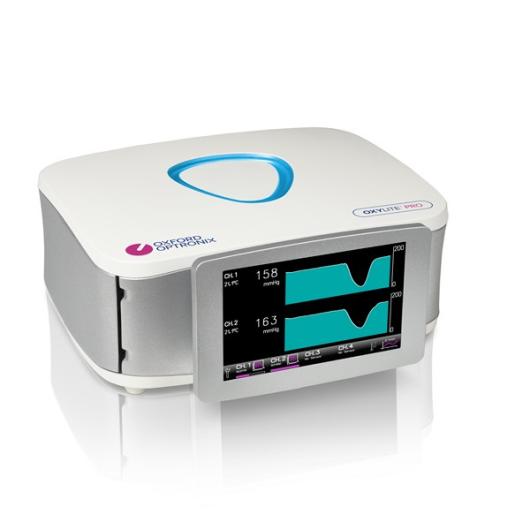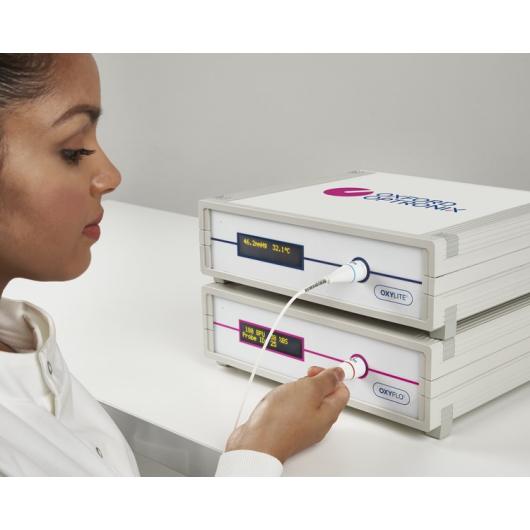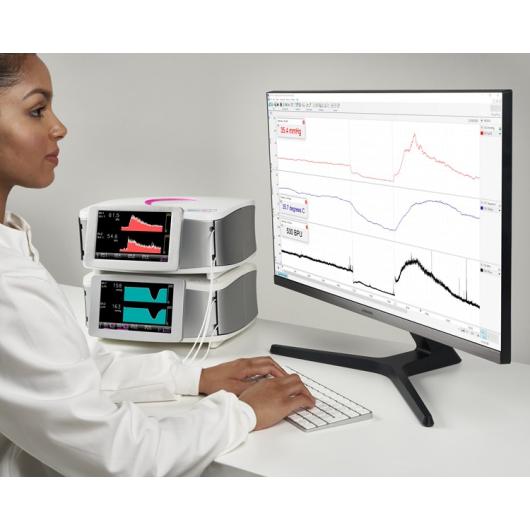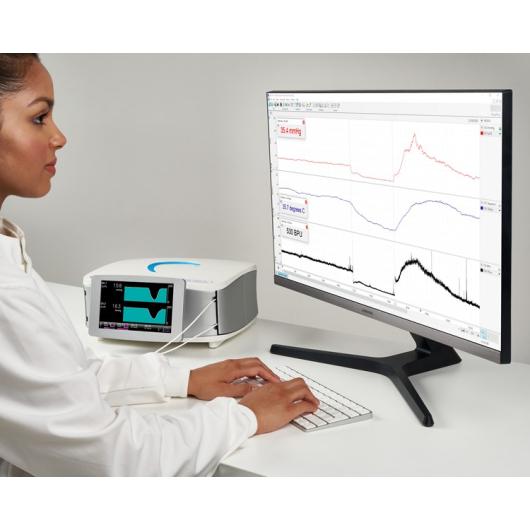





Rent OxyLite system
Dissolved oxygen (pO2) and temperature monitors in 3 versions: single-channel, two- and four-channel. Ask us for rent to your laboratory.
Instrument rental conditions are as such:
- Minimum term – 2 months
- Extendable in 1 or 2 month increments at above pcm price
- Oxygen sensors are purchase-only (per list price)
- Laser Doppler probes only can be rented, subject to availability
- Subject to monitor availability
- Delivery and Return carriage and insurance costs to be borne by the customer or distributor
- All damage, other than fair wear and tear will be chargeable
The survival of tissues and organs relies on an adequate supply of oxygen. The measurement of tissue oxygen tension (ptiO2) provides a direct measurement of the balance between oxygen supply (by the blood) and metabolic oxygen consumption (by the tissue), i.e. a readout of oxygen availability at the cellular level. This is in contrasts to spectroscopy (NIRS) techniques, which merely describe haemoglobin oxygenation status.
OxyLite™ oxygen monitors will be of interest therefore to life scientists wishing to directly and continuously measure dissolved oxygen in the normal physiological as well as hypoxic ranges, both in experimental in vivo models, or in any number of in vitro applications.
Since 1998, when Oxford Optronix pioneered the commercialization of fibre-optic oxygen micro-sensor technology, the OxyLite™ brand has become established the world over in biomedical, boasting in excess of 500 peer-reviewed journal citations and hundreds of units sold worldwide.
2013 saw the culmination of a decade and half of continuous R&D with the launch of our third-generation of tissue oxygen monitors. Blending contemporary design, true plug and play convenience and the very latest in opto-electronic technology, our OxyLite™ Pro systems provide what is simply the most advanced, accurate and reliable tissue oxygen monitoring platform on the market.
Our oxygen sensors leverage state-of-the-art optical fluorescence technology intended for the quantitative measurement of oxygen partial pressure (pO2) and temperature in tissues, physiological fluids, cell cultures and other in vitro applications. This technology offers key advantages over devices based on polarographic technology, making our oxygen monitors much easier to use and ideally suited to oxygen measurements in the typical physiological range, as well as incredibly sensitive under conditions of hypoxia.
Applications for OxyLite and OxyLite Pro
- Tumour angiogenesis and oxygenation
- Vital organ oxygenation during transplantation and shock monitoring
- Cerebral oxygen during stroke
- Brain and spinal cord injury
- Tissue flap and wound oxygenation
- pO2 monitoring in the eye
- Dissolved oxygen measurement in hypoxic cell culture, bioreactors etc.
Key benefits of OxyLite
The easiest-to-use dissolved oxygen monitors in the world!
No calibration procedures, no sensor drift, no obligatory PC/software interface, integrated temperature compensation, oxygen partial pressure displayed in absolute units of mmHg: our world-renowned OxyLite™ oxygen monitors are simply the most user-friendly oxygen monitors available today, period!
Absolute units of dissolved oxygen
The fluorescence-based technique employed by our oxygen monitors provides an absolute measurement of dissolved oxygen in mmHg or kPa. In vivo this provides a direct readout of oxygen availability to cells and tissue, in contrast to blood oxygen saturation assessment (pulse oximetry), which merely describes the haemoglobin oxygenation status of blood.
Sensitivity and accuracy
Third-generation opto-electronics provide unmatched sensitivity, stability and accuracy in the physiologically relevant pO2 range (0 – 200 mmHg) and under conditions of hypoxia (0 – 15 mmHg).
No oxygen consumption
Zero oxygen consumption at the point of measurement, thus innately suitable for continuous and absolute oxygen sensing, even under conditions of extreme hypoxia.
Microchip sensors
‘EEPROM’ technology embedded within our purpose-designed connectors provides unsurpassed ease of use and user convenience by completely eliminating all calibration procedures. Simply ‘plug and go’!
Touch-screen display and interface
OxyLite™ Pro models feature a touch-sensitive, high-contrast, 140? viewing-angle screen, which displays real-time data in both digital and graphical (trace) formats, and provides access to instrument/user settings.
Built-in temperature compensation
Automatic temperature compensation of the pO2 measurement through optional, integrated temperature sensors.
Versatility
Full support for both in vivo (tissue) pO2 applications AND measurement of dissolved oxygen in vitro (e.g. hypoxic cell culture, tissue constructs, bioreactors and more).
Minimally invasive for in vivo applications
Oxygen sensor diameters range from approximately 230 µm – 750 µm to suit a host of tissue monitoring applications and cause minimal tissue disruption in use.
MRI compatibility
Dedicated sensor types provide support and compatibility for magnetic resonance imaging (selected sensor types only).
Multi-channel productivity
The OxyLite™ Pro is available as a 2-channel model or, uniquely, as a 4-channel device (OxyLite™ Pro XL) capable of driving up to 4 sensors simultaneously. This provides the flexibility to suit all needs, including the simultaneous monitoring of oxygen from multiple tissue sites (e.g. comparison of pathological versus control tissue sites), or multiple in vitro samples.
Upgradeable
The OxyLite™ Pro 2-channel model can be factory upgraded to the 4-channel model (OxyLite™ Pro XL).
Single-sensor multi-parameter monitoring
Our OxyLite™ oxygen monitors have been specifically developed for use our OxyFlo™ blood flow monitors. The combination of these two fibre optic measurement systems provides simultaneous tissue blood flow and oxygenation data from each 'triple' parameter combined sensor.
USB digital output
Our entire range of tissue monitoring devices now include a dedicated USB output that supports direct streaming of real-time recordings to a PC running the popular LabChart® Pro* charting software by ADInstruments. After installing a complimentary Add-on, LabChart will automatically identify the specific type and model of Oxford Optronix monitor and pre-load all the necessary configuration and channel settings, providing the ultimate in ‘plug and play’ convenience. For researchers wishing to make multi-parameter measurements, the Add-on supports multiple Oxford Optronix devices at the same time. Data acquisition and recording just got a whole lot easier!
Analogue outputs
Continuous data recording to PC or Mac platforms is also supported via standard analogue data outputs offering compatibility with third party data recording solutions.
Statement of intended use:
OxyLite™ and OxyLite™ Pro are intended for laboratory, industrial and research use only.
OxyLite™ and OxyLite™ Pro are NOT intended for use in human subjects/patients.
- Dimensions
OxyLite: 95mm (H) x 290mm (W) x 260mm (D)
OxyLite Pro: 150mm (H) x 310mm (W) x 280mm (D) - Weight
OxyLite: 2kg / 4.5lbs
OxyLite Pro: 4kg / 9lbs - Operating temperature
10 – 30°C - Operating humidity
0 – 70% (non-condensing) - Power requirements
OxyLite: VAC 100-240V, 50-60Hz, 30W max
OxyLite Pro: External PSU (100-240V/50-60Hz), 40W max - Fuse rating
OxyLite: 2 x T1.6A
OxyLite Pro: Not applicable - Number of sensors supported / Number of channels
OxyLite: 1
OxyLite Pro: 2
OxyLite Pro XL: 4 - Display
OxyLite: 40 character alphanumeric OLED
OxyLite Pro: High contrast 800 x 480 LCD touch-screen - Instrument configuration
OxyLite: Via function button at rear
OxyLite Pro: Via touch-screen display - Analogue voltage outputs
OxyLite: 2 x male BNC connectors (2 outputs)
OxyLite Pro: 1 x 15-pin D-type (4 outputs)
OxyLite Pro XL: 2 x 15-pin D-type (8 outputs) - LED excitation wavelength
525nm - Luminescence wavelength
650nm - PERFORMANCE
- Mode of operation
Luminescence decay lifetime (pO2) / T-type thermocouple or manual user input (temperature) - Measurement units (displayed)
mmHg or kPa / ?C - Measurement range
0 – 200mmHg; 0 – 26.6kPa / 0 – 50?C - Measurement resolution
0.1mmHg / 0.1?C - Measurement accuracy
Oxygen:
±0.7mmHg (0 – 7mmHg)
±10% of reading (7 – 150mmHg)
±15% of reading (150 – 200mmHg)
Temp: ±0.2?C - Measurement response time
< 20s (standard oxygen sensor) / < 2s (temperature) - Measurement sampling rate
1Hz (user definable on OxyLite Pro models) - Measurement acquisition time
1s - Measurement averaging
5s, rolling - Display update interval (numerical)
2s (5s rolling averaged) - Validated temp compensation range
10?C – 45?C - Sensor identification
Automatic; integrated connector EEPROM - Sensor calibration
Factory pre-calibration (unique per sensor); valid 6 months - Sensor shelf-life
2 years from factory calibration (used or unused) - Sensor longevity
48 hours accumulated usage at default sampling rate - Analogue data output range
0 – 5V (0 – 200mmHg / 0 – 50?C) (default) - Analogue data output rate
1Hz
- Sensors for OxyLite system
- LabChart® Pro
- PowerLab®
- Value ADC 12-input analogue data acquisition module.
- NX-CI ADAPTER for implantable ('CI' type) oxygen sensors
- BNC data cables
- BNC adapter cable for OxyLite Pro and OxyFlo Pro models
Download full publication list.
In vivo tissue oxygenation: How do I know which method is best for my research?
by Sarah McFarlane, 18 October 2019
Understanding oxygen sensing in cells: A video lecture by Dr. Peter Ratcliffe.
by Justin Croft, 27 August 2019
Investigating mechanisms driving acute kidney injury arising from heart surgery and sepsis.
by Sarah McFarlane, 12 July 2019
Marina N et al. (2020). Astrocytes monitor cerebral perfusion and control systemic circulation to maintain brain blood flow. Nat Commun 11(1), 131
Sheng T, Ong YH, Guo W and Zhu T (2020). Reactive oxygen species explicit dosimetry to predict tumor growth for benzoporphyrin derivative-mediated vascular photodynamic therapy. J Biomed Opt. 25(6), 1-13
Gehrung M, Bohndiek SE and Brunker J (2019). Development of a blood oxygenation phantom for photoacoustic tomography combined with online pO2 detection and flow spectrometry. J Biomed Opt. 24(12), 1-11
Tran CHT, George AG, Teskey GC and Gordon GR (2019). Seizures cause sustained microvascular constriction associated with astrocytic and vascular smooth muscle Ca2+ recruitment. bioRxiv http://dx.doi.org/10.1101/644039
Baark F, Shaughnessy F, Pell VR, Clark JE, Eykyn TR, Blower P and Southworth R (2019). Tissue acidosis does not mediate the hypoxia selectivity of [64Cu][Cu(ATSM)] in the isolated perfused rat heart. Sci Rep 9(1), 499
Bodo S, et al. (2019). Single-dose radiotherapy disables tumor cell homologous recombination via ischemia/reperfusion injury. J Clin Invest. 129(2), 786-801
Dr Elizabeth Morgan, National Oceanography Centre, University of Southampton, UK
“I use the BF/OT/E PO2 E-series sensor to measure PaO2 in vivo in invertebrates during external environmental fluctuations in PO2. Due to the accuracy and reliability of the PO2 probes we can design experiments that provide real time measurements of PO2 during changes in environmental variables and more accurately link this to behavioural responses. During the experimental set up the staff at Oxford Optronix were always on hand to help out with any technical queries and even visited the laboratory to check out the experimental set up and ensure the probes were working. I would recommend Oxford Optronix to anyone with an interest in measuring PO2 and temperature in marine science.”
Dr Catherine Hoare, Hope Hospital, Manchester, UK
“One particularly useful ability of the OxyLite [is the ability] to observe the oxygen measurements alongside absorbance readings, plotting both the oxygen and enzyme kinetics. This would never have been possible with a standard Clarke Electrode. I am genuinely impressed with the OxyLite, its range of applications and its ease of use. I would be more than happy to recommend it to the scientific community.”
Dr Thies Schroeder, Duke University Medical Center, Department of Radiation Oncology, Durham NC, United States
“Our group has successfully applied OxyLite needle probes to measure changes in tissue oxygenation in response to drug treatment. OxyLite has allowed us to collect important mechanistic data to identify the mechanism of these drug treatments in laboratory animals. We greatly appreciate having a calibrated method like the OxyLite probe technology available that allows the collection of accurate, real-time physiological data from live animals.”
Dr. Roger Evans, Monash University, Department of Physiology, Melbourne, Australia
“Your equipment has taken me to some weird and wonderful places and contributed to about a dozen original articles over the last decade.”
| Naziv proizvoda | |
|---|---|
| OxyLite Single-channel dissolved oxygen (pO2) and temperature monitor | |
| OxyLite Pro Two-channel dissolved oxygen (pO2) and temperature monitors with touch-screen | |
| OxyLite Pro XL Four-channel dissolved oxygen (pO2) and temperature monitors with touch-screen |








